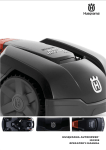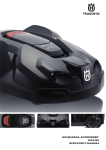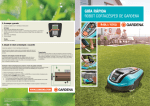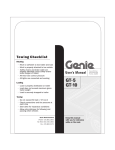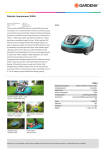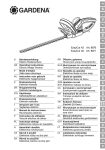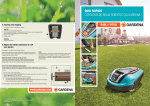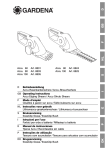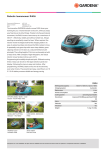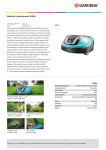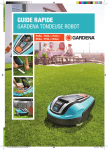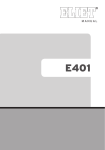Download 3. installation
Transcript
Operator‘s Manual GARDENA Robotic Lawn Mower R40Li TABLE OF CONTENTS 1. Introduction and safety .............................................................. 1.1 Introduction ..................................................................................... 1.2 Symbols on R40Li ....................................................................... 1.3 Symbols in the Operator’s Manual .......................................... 1.4 Safety instructions ........................................................................ 5 5 6 7 8 2. Presentation .................................................................................. 2.1 What’s what? .............................................................................. 2.2 Function ......................................................................................... 2.3 Search method ............................................................................ 10 11 12 14 3. Installation ..................................................................................... 3.1 Preparations ................................................................................. 3.2 Installation of the charging station ....................................... 3.3 Charging the battery .................................................................. 3.4 Installation of the boundary wire ........................................... 3.5 Connecting the boundary wire .............................................. 3.6 Installation of the guide wire .................................................. 3.7 Checking the loop ..................................................................... 3.8 First start-up and calibration ................................................... 3.9 Test docking with the charging station ................................ 15 15 16 19 20 26 27 30 31 31 4. Use .................................................................................................... 4.1 Charging a discharged battery ............................................... 4.2 Using the timer ............................................................................ 4.3 Starting ........................................................................................... 4.4 Stopping ........................................................................................ 4.5 Switching off ................................................................................ 4.6 Adjusting the cutting height ..................................................... 33 33 34 35 35 35 35 5. Control panel ................................................................................ 5.1 Operation selection .................................................................... 5.2 Multi-choice buttons ................................................................... 5.3 Numbers ........................................................................................ 5.4 Main switch ................................................................................... 36 37 38 38 38 6. Menu functions ............................................................................ 6.1 Main menu .................................................................................... 6.2 Menu structure ............................................................................. 6.3 Timer (1) ........................................................................................ 6.4 Security (2) ................................................................................... 6.5 Settings (3) ................................................................................... 39 39 40 41 42 43 7. Garden example .......................................................................... 47 8. Maintenance .................................................................................. 8.1 Winter storage ............................................................................. 8.2 After winter storage .................................................................... 8.3 Cleaning ........................................................................................ 8.4 Transport and removal .............................................................. 8.5 In the case of thunderstorms .................................................. 8.6 Replacing the blades ................................................................ 8.7 Replacing the battery ................................................................ 50 51 51 52 53 53 53 54 9. Trouble shooting ........................................................................ 9.1 Messages ...................................................................................... 9.2 Indicator lamp in the charging station .................................. 9.3 Symptom ....................................................................................... 9.4 Finding breaks in the loop wire .............................................. 55 55 58 59 61 10. Technical data ........................................................................... 65 11. Guarantee terms ....................................................................... 66 12. Environmental information .................................................. 66 13. EU declaration of conformity .............................................. 67 English - 3 MEMO Serial number: PIN code: Product registration key: The Product Registration Key is a valuable document and must be stored in a safe place. This key is necessary for example to register the product on GARDENA’s website or to unlock the mower in the event of a lost PIN code. If the mower is stolen, it is important to notify GARDENA of this. Contact GARDENA Central Service and provide the mower’s serial number and product registration key so that it can be registered as stolen in an international database. This is an important step in the mower’s theft protection which reduces interest in the buying and selling of stolen mowers. Always have the mower’s serial number at hand when you contact GARDENA Central Service, as this will provide you with faster support. GARDENA Central Service www.gardena.com/int 4 - English 1. INTRODUCTION AND SAFETY 1. Introduction and safety 1.1 Introduction Congratulations on your choice of an exceptionally high quality product. To get the best results from your GARDENA R40Li requires knowledge of its function. This Operator's Manual contains important information about the mower, how it must be installed and how to use it. As a complement to this Operator’s Manual, there is more information available on GARDENA’s website, www.gardena.com/int Here you can find more help and guidance in the use of R40Li. www.gardena.com/int The following system is used in the Operator's Manual to make this easier: • Text written in italics is a text that is shown on the mower's display or is a reference to another section of the Operator's Manual. • Words written in bold are one of the buttons on the mower's keypad. • Words written in UPPERCASE and italics refer to the position of the main switch and the different operating modes on the mower. GARDENA has a policy of continuous product development and therefore reserves the right to modify the design and appearance and function of products without prior notice. IMPORTANT INFORMATION Read through the Operator’s Manual carefully and understand the content before using your R40Li. WARNING R40Li can be dangerous if incorrectly used. English - 5 1. INTRODUCTION AND SAFETY 1.2 Symbols on R40Li These symbols can be found on the robotic lawn mower. Study them carefully. • Read through the Operator’s Manual carefully and understand the content before using your R40Li. The warnings and safety instructions in this Operator’s Manual must be carefully followed if the mower is to be used safely and efficiently. • R40Li can only start when the main switch is moved to the 1 position and the correct PIN code has been entered. Inspection and/or maintenance must be carried out with the main switch set to 0. • Remain at a safe distance from the R40Li when it is running. Keep your hands and feet away from the rotating blades. Never place your hands or feet close to or under the body when R40Li is in operation. • Do not ride on R40Li. • This product conforms to the applicable EU Directives. • It is not permitted to dispose of this product as normal household waste when it has reached the end of its useful life. Ensure that the product is recycled in accordance with local legal requirements. • Never use a high-pressure washer or even running water to clean R40Li. 6 - English 1. INTRODUCTION AND SAFETY 1.3 Symbols in the Operator’s Manual These symbols can be found in the Operator’s Manual. Study them carefully. • Turn the main switch to 0 before carrying out any inspections and/or maintenance. • Always wear protective gloves when working with the mower’s underframe. • Never use a high-pressure washer or even running water to clean R40Li. • A warning box indicates a risk of personal injury exist, especially when the stated instructions are not followed. WARNING Xxxxxx xxxxx xxxx xxxx xxxxx xxx. • An information box indicates a risk of material damage exist, especially when the stated instructions are not followed. The box is also used where there is a risk of user error. IMPORTANT INFORMATION Xxxxxx xxxxx xxxx xxxx xxxxx xxx. English - 7 1. INTRODUCTION AND SAFETY 1.4 Safety instructions Use • This robotic lawn mower is designed to mow grass in open and level ground areas. It may only be used with the equipment recommended by the manufacturer. All other types of use are incorrect. The manufacturer’s instructions with regard to operation, maintenance and repair must be followed precisely. • The robotic lawn mower may only be operated, maintained, and repaired by persons that are fully conversant with its special characteristics and safety regulations. Please read the Operator’s Manual carefully and make sure you understand the instructions before using the robotic lawn mower. • It is not permitted to modify the original design of R40Li. All modifications are made at your own risk. • Check that there are no stones, branches, tools, toys or other objects on the lawn that can damage the blades and cause the mower to stop. Start R40Li according to the instructions. When the main switch is in the 1 position make sure to keep your hands and feet away from the rotating blades. Never put your hands and feet under the mower. • Never lift up R40Li or carry it around when the main switch is in the 1 position. • Do not let persons who do not know how R40Li works and behaves use the mower. • Never use R40Li if persons, especially children, or pets, are in the immediate vicinity. • Do not put anything on top of R40Li or its charging station. • Do not allow R40Li to be used with a defective blade disc or body. Neither should it be used with defective blades, screws, nuts or cables. • Do not use R40Li if the main switch does not work. • Always switch off the R40Li using the main switch when the mower is not in use. R40Li can only start when the main switch is set to 1 and the correct PIN code has been entered. • R40Li must never be used at the same time as a sprinkler. In this case use the timer function, see 6.3 Timer (1) on page 41, so the mower and sprinkler never run simultaneously. • GARDENA does not guarantee full compatibility between the R40Li and other types of wireless systems such as remote controls, radio transmitters, hearing loops, buried electric animal fencing or similar. 8 - English 1. INTRODUCTION AND SAFETY Transport The original packaging should be used when transporting R40Li over long distances. To safely move from or within the working area: 1. Press the STOP button to stop the mower. If security is set to the medium or high level (see 6.5 Security), the PIN code has to be entered. The PIN code contains four digits and is selected when you start the mower for the first time. See 3.8 First start-up and calibration. 2. Set the main switch to 0. 3. Carry the mower by the handle at the rear under the mower. Carry the mower with the blade disc away from the body. IMPORTANT INFORMATION Do not lift the mower when it is parked in the charging station. This may damage the charging station and/or the mower. Open the cover and instead first pull the mower out of the charging station before lifting it. Maintenance WARNING When the mower is turned upside down the main switch must always be set to the 0 position. The main switch should be set to the 0 position during all work on the mower’s underframe, such as cleaning or replacing the blades. • Inspect R40Li each week and replace any damaged or worn parts. Check especially that the blades and blade disc are not damaged. Replace all blades and screws at the same time if necessary so that the rotating parts are balanced, see 8.6 Replacing the blades. English - 9 2. PRESENTATION 2. Presentation This chapter contains information that is important to be aware of when planning the installation. An installation of GARDENA R40Li includes four main components: • R40Li, a robotic lawn mower that mows the lawn by essentially operating in a random pattern. The mower is powered by a maintenance-free battery. The mower is powered by a maintenance-free battery. • Charging station, where your R40Li returns when the charge level in the battery becomes too low. The charging station has three functions: • To send control signals along the boundary wire. • Sending control signals in the guide wire so that R40Lican find the charging station. • To charge R40Li battery. • Transformer, which is connected between the charging station and a 230V wall socket. The transformer is connected to the wall socket and to the charging station using a 10 m long low voltage cable. The low voltage cable must not be shortened or extended. • Wire, laid in a loop around R40Li working area. The boundary wire is laid around the edges of the lawn and around objects and plants that the mower must not run into. The wire is also used as the guide wire. The wire supplied with the installation is 150 m long. If this is not sufficient more wire can be purchased, with a connector, and spliced onto the existing wire. The maximum permitted length for the loop wire is 250 m. 10 - English 2. PRESENTATION 2.1 What’s what? 2 3 5 4 1 6 7 1 2 3 4 5 15 Start 14 9 12 3 5 6 7 8 9 13 17 10 18 2 4 0 11 8 1 16 19 20 21 22 23 24 The numbers in the picture correspond to: 1. 2. 3. 4. 5. 6. 7. 8. 9. 10. 11. 12. 13. Body Cover to display, keypad and cutting height adjustment Stop button/Lock button for opening the cover Contact strip LED for operation check of the charging station, boundary wire and guide wire Charging station Handle Battery cover Blade disc Chassis box with electronics, battery and motors Main switch Rear wheel Charging strip 14. 15. 16. 17. 18. 19. 20. 21. 22. Keypad Display Loop wire for boundary wire and guide wire Low voltage cable Connector for the loop wire Screws for securing the charging station Transformer Staples Measurement gauge for help when installing the boundary wire (the measurement gauge is broken loose from the box) 23. Coupler for the loop wire 24. Operator´s Manual English - 11 2. PRESENTATION 2.2 Function Capacity R40Li is recommended for lawns up to 400 m2 in size. How big an area R40Li can keep cut depends primarily on the condition of the blades and the type, growth and moisture of the grass. The shape of the garden is also significant. If the garden mainly consists of open lawns, R40Li can mow more per hour than if the garden consists of several small lawns separated by trees, flower beds and passages. A fully charged R40Li mows for 30 to 70 minutes, depending on the age of the battery and how thick the grass is. Then the mower will charge for approx. 80 to 100 minutes. The charging time can vary depending on, among other factors, the ambient temperature. Mowing technique The mowing system used by R40Li is based on an effective and energy efficient principle. Unlike normal robotic lawn mowers, R40Li cuts the grass instead of striking it off. We recommend you allow R40Li to mainly mow in dry weather to obtain the best possible result. R40Li can even mow in the rain, however, wet grass easily collects on the mower and the risk of slipping on steep slopes is greater. If there is risk for thunder, the transformer should be disconnected from the power and the boundary wire and the guide wire from the charging station. The blades must be in good condition to obtain the best mowing result. In order to keep the blades sharp for as long as possible it is important to keep the lawn free from branches, small stones and other objects. Replace the blades regularly for the best mowing result. It is very easy to replace the blades. See 8.6 Replacing the blades on page 53. 12 - English 2. PRESENTATION Working method The R40Li automatically mows the lawn. It continuously combines mowing and charging. The mower starts to search for the charging station when the battery charge becomes too low. R40Li does not mow when it is searching for the charging station. When R40Li searches for the charging station, it first searches irregularly for the guide wire. Then it follows the guide wire to the charging station, turns around just in front of the station and backs into it. When the battery is fully charged, the mower leaves the charging station and starts mowing in a randomly selected direction within the 90˚ to 270˚ exit sector. To ensure an even cut, even in inaccessible parts of the garden, the lawn mower can follow the guide wire out from the charging station to where the guide wire connects to the boundary wire to begin mowing there. When R40Li body hits an obstacle, the mower reverses and selects a new direction. Two sensors, one at the front and one at the back on R40Li, sense when the mower approaches the boundary wire. The R40Li overruns the wire by up to 28 centimetres before it turns back. The STOP button on the top of R40Li is mainly used to stop the mower when it’s running. When the STOP button is pressed a cover opens, behind which there is a control panel. The STOP button remains depressed until the cover is closed again. This acts as start inhibitor. English - 13 2. PRESENTATION The control panel on the top of R40Li is where you manage all the mower settings. Open the control panel cover by pressing down the STOP button. When the main switch is turned to 1 for the first time, a start-up sequence begins which includes the selection of the language, time format, date format and four-digit PIN code as well as setting of the time and date. See 3.8 First start-up and calibration for setting the main switch to position 1. See 6.4 Security (2) on page 42 for more information on theft protection. Movement pattern The mower’s movement pattern is irregular and is determined by R40Li itself. A movement pattern is never repeated. This mowing system means the lawn is mown equally without any mowing lines. 2.3 Search method R40Li runs irregularly until it reaches the guide wire. The mower then follows the guide wire in to the charging station. The guide wire is a cable that is laid from the charging station towards, for instance, a remote part of the working area or through a narrow passage to be then connected with the boundary wire. For more information, see 3.6 Installation of the guide wire 14 - English 1 2 3 Start 1 2 3 4 5 6 7 8 9 0 4 5 3. INSTALLATION 3. Installation This chapter describes how you install the GARDENA R40Li. Before starting the installation read the previous chapter 2. Presentation. Read also through this entire chapter before beginning the installation. How the installation is made also affects how well R40Li will work. It is therefore important to plan the installation carefully. Planning is simplified if you make a sketch of the working area, including all obstacles. This makes it easier to see the ideal positions for the charging station, the boundary wire and the guide wire. Draw on the sketch where the boundary and guide wires should be routed. In chapter 7. Garden example, there are examples of installations. Visit also www.gardena.com/int for further descriptions and tips regarding installation. Carry out the installation in the following steps: 3.1 Preparations. 3.2 Installation of the charging station. 3.3 Charging the battery. 3.4 Installation of the boundary wire. 3.5 Connecting the boundary wire. 3.6 Installation of the guide wire. 3.7 Checking the loop. 3.8 First start-up and calibration 3.9 Test docking with the charging station The charging station and boundary and guide wires must be connected to be able to carry out a complete start-up of the R40Li. 3.1 Preparations 1. If the lawn in the proposed working area is taller than 10 cm, mow it using a normal lawn mower. Then collect the clippings. 2. Read carefully through all the steps before the installation. 3. Check that all parts for the installation are included: The numbers in brackets refer to the detail diagram 2.1 What’s what?. • Operator’s Manual (24) • R40Li • Charging station (6) • Loop wire for the boundary wire and guide wire (16) English - 15 3. INSTALLATION • Transformer (20) • Low voltage cable (17) • Staples (21) • Connector for the loop wire (18) • Screws for the charging station (19) • Measurement gauge (22) • Solderless coupler for the loop wire (23) During installation you will also need: • Hammer/plastic mallet to simplify putting the staples in the ground • Combination pliers for cutting the boundary wire and pressing the contact units together. • Edge cutter/straight spade if the boundary wire must be buried. 3.2 Installation of the charging station Ideal position of the charging station Take the following aspects into consideration when identifying the best location for the charging station: • Allow for 3 metres of free space in front of the charging station • It must be possible to lay at least 1.5 metres of boundary wire straight out to the right and left of the charging station. • Close to a wall socket. The supplied low voltage cable is 10 metres long. • A level surface to place the charging station on. • Protection from water spray for instance from irrigation • Protection from direct sunlight • Place in the lower part of a working area that has a major slope • Possible requirement to keep the charging station out of sight for outsiders • Any aesthetic preferences For examples of where best to install the charging station, see 7. Garden example on page 47. 16 - English 3. INSTALLATION The charging station must be positioned with a great deal of free area in front of it (at least 3 metres). It should also be centrally placed in the working area so that R40Li finds it easier to reach all areas in the working area. Do not put the charging station in confined spaces in the working area. There must be a straight boundary wire, at least 1.5 metres long, to the right and left of the charging station. The wire must be laid straight out from the rear end of the charging station. Any other locations can mean that the lawn mower enters the charging station sideways and will have difficulty docking. Do not put the charging station in a corner in the working area. There must be a straight boundary wire, at least 1.5 metres long, to the right and left of the charging station. 3020-043 The charging station must be positioned on relatively level ground. The front end of the charging station must be a maximum of 3 cm higher than the back end. The front end of the charging station must never be lower than the back end. 3 The charging station must not be positioned so that its plate bends. English - 17 3. INSTALLATION If the installation is done in a working area with a steep slope (such as around a house on a hill), the charging station should be placed in the area at the bottom of the slope. This makes it easier for the lawn mower to follow the guide wire to the charging station. The charging station should not be placed on an island as this limits the laying of the guide wire in an optimal way. If the charging station has to be installed on an island, the guide wire also has to be connected to the island. See the picture opposite. Read more about islands in the chapter 3.4 Installation of the boundary wire. Connecting the transformer Take the following into consideration when planning where to place the transformer: • Close to the charging station • Protection from rain • Protection from direct sunlight If the transformer is connected to an electrical socket outdoors, this must be approved for outdoor use. The low voltage cable to the transformer is 10 meters long, and may not be shortened or extended. It is possible to let the low voltage cable cross the working area. The low voltage cable must be stapled down or buried, and the cutting height should be such that the blades on the blade disc can never come in contact with the low voltage cable. The transformer must be placed where it is well ventilated and is not exposed to direct sunlight. The transformer must be placed under a roof. It is recommended to use an earth fault-breaker when connecting the transformer to the wall socket. For best performance, the transformer must not be exposed to direct sunlight. IMPORTANT INFORMATION The low voltage cable must not be shortened nor extended. IMPORTANT INFORMATION Place the low voltage cable so that the blades on the blade disc can never come in contact with it. 18 - English 3. INSTALLATION Installation and connecting the charging station 1. Position the charging station in a suitable spot. 2. Connect the low voltage cable to the charging station. 3. Connect the transformer’s power cable to a 230V wall socket. If the transformer is connected to wall socket outdoors, it must be approved for outdoor use. 4. Attach the charging station to the ground using the supplied screws. Ensure the screws are screwed all the way down in the countersink. IMPORTANT INFORMATION It is not permitted to make new holes in the plate. Only the existing holes may be used to secure the plate to the ground. IMPORTANT INFORMATION Do not tread or walk on the charging station plate. 3.3 Charging the battery As soon as the charging station is connected, it is possible to charge the mower. The mower can be charged as soon as the charging station is connected. Set the main switch to the 1 position. Place R40Li in the charging station to charge the battery while the boundary and guide wires are being laid. If the battery is flat, it takes around 80 to 100 minutes to fully charge it. IMPORTANT INFORMATION R40Li cannot be used before the installation is complete. English - 19 3. INSTALLATION 3.4 Installation of the boundary wire The boundary wire can be installed in one of the following ways: 1. Securing the wire to the ground with staples. It is preferable to staple down the boundary wire if you want to make adjustments to the boundary wire during the first few weeks of operation. After a few weeks the grass will have grown over the wire making it no longer visible. Use a hammer/plastic mallet and the staples supplied when carrying out the installation. 2. Bury the wire. It is preferable to bury the boundary wire if you want to dethatch or aerate the lawn. If necessary both methods can be combined so one part of the boundary wire is stapled down and the remainder is buried. The cable can be buried using for instance an edge cutter or a straight spade. Make sure to lay the boundary wire at least 1 cm and a maximum of 20 cm in the ground. Best position for the boundary wire The boundary wire must be laid so it: • Forms a loop around the working area for the R40Li. Only GARDENA boundary wire must be used. It is specially designed to resist dampness from the soil that could otherwise easily damage the wires. • The mower is never more than 15 metres from the wire at any point in the entire working area. • The wire is no more than 250 metres long. • 20 cm of extra wire is available to which the guide wire will be connected to later. See 3.6 Installation of the guide wire on page 27. Depending on what the working area is adjacent to, the boundary wire must be at laid at different distances from obstacles. The illustration below shows how the boundary wire must be laid around the working area and around obstacles. Use the supplied measurement gauge to obtain the correct distance (see 2.1 What’s what? on page 11 ). 20 - English 3. INSTALLATION Boundaries for the working area If a high obstacle, for example a wall or fence, borders the working area, the boundary wire should be laid 30 cm from the obstacle. This will prevent R40Li from colliding with the obstacle and reduce body wear. About 20 cm around the fixed obstacle will not be mown. If the working area borders against a small ditch, for example, a flower bed or a small elevation, e.g. a low verge (3 - 5 cm), the boundary wire should be laid 20 cm inside the working area. This prevents the wheels from driving into the ditch or up onto the verge. About 12 cm of grass along the ditch/stone edging will not be mown. If the working area borders against a flat path or the like that lies level with the lawn, it is possible to allow R40Li to run a little over the path. The boundary wire should then be laid 5 cm from the edge of the path. All the grass along the side of the pavement will be cut. When the working area is divided by a flat slab path that is level with the lawn, it is possible to allow R40Li to run over the path. It can be an advantage to lay the boundary wire under the slabs. The boundary wire can also be laid in the joint between the slabs. Note! The R40Li must never run over gravel, mulch or similar material which can damage the blades. IMPORTANT INFORMATION If the working area is adjacent to water bodies, slopes, precipices or a public road, the boundary wire must be supplemented with a fence or the like. The height must then be at least 15 cm. This will prevent R40Li from ending up outside the working area under any circumstances. Min. 15cm English - 21 3. INSTALLATION Boundaries within the working area Use the boundary wire to demarcate areas inside the working area by creating islands around obstacles that can not withstand a collision, for example, flower beds and fountains. Obstacles that can withstand a collision, for example, trees or bushes higher than 15 cm, do not need to be demarcated by the boundary wire. R40Li will turn when it collides with this type of obstacle. To achieve careful and silent operation, it is recommended to isolate all fixed objects in and around the working area. Run the cable out to the area, route it around the area to be demarcated and then back along the same route. If staples are used, the wire should be laid under the same staple on the return route. When the boundary wire to and from the island are close together, the mower can drive over the wire. The boundary wire may not be crossed on its way to and from an island. Obstacles that slope slightly, for example, stones or large trees with raised roots, must be isolated with an island or removed. R40Li can otherwise slide up onto this kind of obstacle causing the blades to be damaged. Secondary areas If the working area consists of two areas which the mower has difficulty travelling between, it is recommended to set up a secondary area. Instances of this are 25% slopes or a passage that is narrower than 150 cm. Run the boundary wire then around the secondary area so that it forms an island outside of the main area. The R40Li must be moved manually between the main and secondary area when the lawn in the secondary area has to be cut. The MAN operation mode must be used as the lawn mower cannot travel on its own from the secondary area to the charging station. See 5.1 Operation selection on page 37. In this mode, the R40Li will never look for the charging station but will mow until the battery runs out. When the battery is flat, the mower will stop and the ‘Needs manual charging’ message will appear in the display. Then place the mower in the charging station to charge the battery. If the main working area has to be cut after charging, it is appropriate to switch the operation mode to Auto before placing the mower in the charging station. Passages when mowing Long and narrow passages and areas narrower than 1.5 - 2 metres should be avoided. When the R40Li mows there is a risk that it travels around in the passage or area for a period of time. The lawn will then look flattened. 22 - English Secondary area Main area 3. INSTALLATION Slopes The boundary wire can be laid across a slope that slants less than 10 %. The boundary wire should not be laid across a slope that is steeper than 10 %. There is a risk of R40Li finding it difficult to turn there. The mower will then stop and show the fault message Outside working area. The risk is at its greatest in damp weather conditions, as the wheels can slip on the wet grass. However, the boundary wire can be laid across a slope steeper than 10 % when there is an obstacle that R40Li can be permitted to collide with, for example, a fence or a dense hedge. R40Li can mow areas inside the working area that slope up to 25 cm per distance metre (25 %). Areas that slope more must be demarcated by the boundary wire. When any part of the working area's boundary slopes more than 10 cm per distance metre (10 %), the boundary wire must be routed about 20 cm in on flat ground before the slope starts. 2 English - 23 3. INSTALLATION Laying out the boundary wire If you intend to staple down the boundary wire: • Cut the grass very low with a standard lawn mower or a trimmer where the wire is to be laid. It will then be easier to lay the wire close to the ground and the risk of the mower cutting the wire or damaging the insulation of the wire is reduced. • Make sure to lay the boundary wire tight to the ground and secure the staples close together with approximately 75 cm between each staple. The wire must generally lie close to the ground so, as not to be cut off before the grass roots have grown over it. • Use a hammer to knock down the staples in the ground. Exercise care when knocking in the staples and make sure the wire is not under strain. Avoid forming the wire in sharp bends. If the boundary wire is to be buried: • Make sure to place the boundary wire at least 1 cm and a maximum of 20 cm into the ground. The wire can be buried for instance using an edge cutter or a straight spade. Use the supplied measurement gauge as a guide when you lay out the boundary wire. This helps you to easily set the correct distance between the boundary wire and the boundary/obstacle. The measurement gauge is broken loose from the box. IMPORTANT INFORMATION Extra wire must not be placed in coils outside the boundary wire. This can disrupt R40Li. Loop for connecting the guide wire To facilitate the connection of the guide wire to the boundary wire, it is recommended to create a loop with about 20 cm of extra boundary wire at the point where the guide wire will later be connected. It is a good idea to plan where the guide wire will be placed before laying out the boundary wire. See 3.6 Installation of the guide wire on page 27. 24 - English 3. INSTALLATION Laying the boundary wire in towards the charging station The boundary wire must be laid in line with the rear end of the charging station. If the boundary wire is laid in any other way, R40Li may find it hard to enter the charging station. In many cases, the straight wire section to the left of the charging station can be reduced to 1 metre. Depending on how the boundary wire is laid in the rest of the installation, the straight wire section to the right of the charging station may need to be extended in certain cases. Joining the boundary wire Use an original coupler if the boundary wire is not long enough and needs to be spliced.It is waterproof and gives a reliable electrical connection. Insert both wire ends in the coupler. Make sure the wires are fully inserted in the coupler by checking that the wire ends are visible through the transparent area on the other side of the coupler. Now press down the button on top of the coupler fully. Use a pair of pliers if the button on the coupler is difficult to press down by hand. IMPORTANT INFORMATION Twinned cables, or a screw terminal block that is insulated with insulation tape are not satisfactory splices. Soil moisture will cause the conductors to oxidise and after a while result in a broken circuit. English - 25 3. INSTALLATION 3.5 Connecting the boundary wire Connect the boundary wire to the charging station: IMPORTANT INFORMATION The boundary wire must not be crossed when connecting to the charging station. The right hand wire end must be connected to the right hand pin on the charging station and the left hand wire end to the left pin. 1. Place the cable ends in the connector: • Open the connector. • Place the wire in the connector grip. 2. Press the connector together using a pair of pliers. Press until you hear a click. 3. Cut off any surplus boundary wire. Cut 1 - 2 cm above respective connectors. 4. Press the connector onto the contact pin, marked A, on the charging station. Carefully check that the connector is properly fitted. IMPORTANT INFORMATION The right hand connector must be connected to the right hand metal pin on the charging station and the left hand wire end to the left connector. 26 - English 3. INSTALLATION 3.6 Installation of the guide wire The guide wire is a wire that is laid away from the charging station, for instance out towards a remote part of the working area or through a narrow passage and then connected with the boundary wire. The same cable roll is used for both the boundary and guide wires. The guide wire is used by the R40Li to find its way back to the charging station but also to guide the mower to remote areas of the garden. To ensure an even cut over the entire lawn, the mower can follow the guide wire from the charging station to the guide wire connection in the boundary wire and start mowing there. Depending on the garden layout, one should adjust how often the mower is to follow the guide wire from the charging station. See 6.5 Settings (3) on page 43. The mower must be run at varying distances from the guide wire to reduce the risk of tracks forming when the mower follows the guide wire to/from the charging station. The area beside the wire which the mower then uses is called the Corridor. The mower always runs to the left of the guide wire as seen facing the charging station. Thus the corridor is to the left of the guide wire. The corridor is 50 cm wide. When installing, it is therefore important to have at least 75 cm free space to the left of the guide wire and at least 25 cm free space to the right of the guide wire, as seen facing the charging station. It is not allowed to lay the guide wire closer than 30 cm from the boundary wire. The guide wire, as the boundary wire, can be stapled to or buried in the ground. IMPORTANT INFORMATION Make sure that there is always at least 75 cm of free space to the left of the guide wire as seen facing the charging station. English - 27 3. INSTALLATION Placement and connection of the guide wire 1. Draw the wire through the slot in the bottom of the charger plate. 2. Fit the connector to the guide wire in the same way as for the boundary wire in 3.5 Connecting the boundary wire. Connect it to the contact pin on the charging station that is labelled “guide”. 3. Route the guide wire at least 2 metres straight out from the front edge of the charging plate. If the guide wire must be laid in a passage: - the R40Li follows the guide wire on the same side of the wire to and from the charging station. This means that the guide wire is to the right of the mower when the mower travels to the charging station while it is to the left of the mower when the mower travels away from the station. 28 - English 3. INSTALLATION - In the passage, the guide wire must therefore be placed so that the mower has as much space to run in as possible. The distance between the boundary wire and the guide wire must however be at least 30 cm. Maximum distance At least 30 cm/12” At least 2m/7ft If the guide wire has to be installed on a steep slope, it is an advantage to lay the wire at an angle to the slope. This makes it easier for the mower to follow the guide wire on the slope. Avoid laying the wire at sharp angles. This can make it difficult for the mower to follow the guide wire. 4. 5. Run the guide wire up to the point on the boundary wire where a loop to facilitate the connection of the guide wire was previously added. Cut the loop on the boundary wire using for instance a pair of wire cutters. 135º 135º 90º English - 29 3. INSTALLATION 6. Connect the guide wire to the boundary wire with the help of a solderless coupler: Insert the boundary wire in each of the holes in the coupler. Insert the guide wire in the centre hole in the coupler. Check that the wires are fully inserted into the coupler so that the ends are visible through the transparent area on the other side of the coupler. Use pliers to completely compress the button on the coupler. It does not matter which holes are used to connect each wire. 7. Staple down/bury the connector in the lawn. IMPORTANT INFORMATION Test that the guide wire works using the Calibrate guide (3-5) function before using the mower. See 3.8 First start-up and calibration on page 31. IMPORTANT INFORMATION The guide wire may not cross the boundary wire, for instance a boundary wire that is laid out to an island. 3.7 Checking the loop Check the loop signal by inspecting the indicator lamp on the charging station. • Steady green light = good signals. • Flashing blue light = interruption in the boundary wire, no signal. • Flashing yellow light = interruption in the guide wire, no guide signal. • Flashing red light = interruption in the charging station's antenna plate, no remote signal available. Contact GARDENA Central Service to rectify. See MEMO on page 4. • Steady blue light = weak signal. This may depend on the boundary wire being over 250 m in length or that the wire is damaged. If the mower still works, this is not a problem. • Steady red light = fault in a circuit board in the charging station. Contact GARDENA Central Service to rectify. See MEMO on page 4. See 9.2 Indicator lamp in the charging station on page 58 if the lamp does not indicate a solid green light. 30 - English 3. INSTALLATION 3.8 First start-up and calibration Before the mower is operated, a start-up sequence in the mower’s menu must be carried out as well as an automatic calibration of the guide signal. The calibration is also a good test to see that the installation of the guide wire has been done in such a way that the mower can easily follow the guide wire from the charging station. 1. Set the main switch to position 1. 2. Open the control panel cover by pressing the STOP button. A start-up sequence begins when the R40Li is started for the first time. The following is requested: • Language • Time format • Current time • Date format • Date • Four digit PIN code. All combinations except 0000 are permitted. IMPORTANT INFORMATION Use MEMO on page 4 to make a note of the PIN code. 3. Place the mower in the charging station as requested in the display. The mower will now start the guide calibration, by leaving the charging station and following the guide wire to the point where the guide wire is connected to the boundary wire to begin mowing there. Check that the mower can follow the guide wire all the way. If it cannot, this may be due to an incorrectly installed guide wire. In this case, check that the installation is performed as described in chapter 3.6 Installation of the guide wire on page 27. 3.9 Test docking with the charging station Before using the mower, check that it can follow the guide wire all the way to the charging station and easily docks with the charging station. Perform the test below. 1. Open the control panel cover by pressing the STOP button. 2. Place the mower close to the point where the guide wire is connected to the boundary wire. Place the mower about 2 metres from the guide wire, facing the guide wire. English - 31 3. INSTALLATION 3. Select Home mode by pressing the house symbol key and pressing OK when the cursor is at Home. Press Start and close the cover. 4. Check that the mower follows the guide wire all the way to the charging station and that it docks with the charging station. The test is approved only if the mower is able to follow the guide wire the entire distance to the charging station and dock at the first attempt. If the mover is unable to dock on the first attempt, it will automatically try again. The installation is not approved if the mower needs two or more attempts to dock with the charging station. In this case, check that the charging station, the boundary wire and the guide wire are installed in accordance with the instructions in Chapters 3.2, 3.4 and 3.6. 5. The mower will stay in the charging station until Auto or Man mode is selected. See 5.1 Operation selection on page 37. The guide system must first be calibrated if the above test is to provide a satisfactory result. See 3.8 First start-up and calibration on page 31. 32 - English 4. USE 4. Use 4.1 Charging a discharged battery When GARDENA R40Li is new or has been stored for a long period the battery will not be charged and needs to be charged before starting. Charging takes approximately 80 to 100 minutes. 1. Set the main switch to the 1 position. 2. Place R40Li in the charging station. Open the cover and slide the mower in as far as possible to ensure proper contact between the mower and the charging station. 3. The display shows a message that charging is in progress. WARNING Read the safety instructions before you start your R40Li. WARNING Keep your hands and feet away from the rotating blades. Never put your hands or feet close to or under the body when the motor is running. English - 33 4. USE 4.2 Using the timer 24 h A B 2:30 h Standby The factory setting for the timer is 07:00-22:00 and it can operate every day of the week. This setting is suitable for a working area of about 400 m2. Mowing Ch arg ing The lawn should not be cut too often to obtain the best mowing result. Use the timer function (see 6.3 Timer (1) to avoid a downtrodden lawn and to get the maximum life from your R40Li. When setting the timer, calculate that R40Li mows around 30 m2 per hour and day. For example; if the working area is 300 m2, the mower must operate for 10 hours a day. The R40Li has an inbuilt standby period of at least 11 hours a day. The standby period provides for instance a good opportunity to water or play games on the lawn. Operation If the timer setting is divided into two work hours, the standby period can be divided into a number of periods. The maximum operating time can however be a maximum of up to 13 hours. When in operation, the mower alternates between mowing and charging. Example 1 Operation A = Max 13 h A Charging/Standby B = Min 11 h Work hour 1: 07:00 - 22:00 Week days: All days 24 h A B 2:30 h Example 2 Standby Work hour 1: 06:00 - 16:00 Work hour 2: 20:00 - 23:00 Mowing Cha rgin g The factory setting ensures that the mower begins cutting the lawn at 07.00. The mower is parked in the charging station from 22.00 and rests until it starts cutting again at 07.00. Operation Week days: All days The mower will operate between 06:00 and 16:00. It will begin again at 20:00 but stop running at 22:00 to rest until it starts again at 06:00. Standby Example 3 Operation Work hour 1: 20:00 - 06:00 Weekdays: Monday to Saturday The mower will operate from Monday 00:01 to Saturday 23:59. As this work hour entails an operational period of 10 hours a day, there is no need to stop operations to obtain the correct standby period. The above times are approximate. The times depend for instance on grass quality, knife sharpness and battery age. If the size of the working area allows it, the quality of the grass can be further improved if it is cut every other day instead of a few hours every day. In addition, the grass benefits from resting completely during at least a three-day period once a month. 34 - English C D Operation A + C= Max 13 h Charging/Standby B + D= Min 11 h 4. USE 4.3 Starting 1. Set the main switch to the 1 position. 2. Press the STOP button to open the control panel cover. 3. Enter the PIN code. 4. Push the Start button. 5. Shut the cover within 10 seconds. Start 1 2 3 4 5 6 8 9 7 If the mower is parked in the charging station, it will only leave the charging station when the battery is fully charged and if the timer is set to allow the mower to operate. 0 Before the blade disc starts, 5 beeps are heard for 2 seconds. 4.4 Stopping 1. Press the STOP button. R40Li stops, the blade motor stops and the control panel cover opens. 4.5 Switching off 1. Press the STOP button. 2. Set the main switch to the 0 position. Always switch R40Li off using the main switch if it requires maintenance or if the mower must be moved outside the working area. 4.6 Adjusting the cutting height The cutting height can be varied from MIN (2 cm) to MAX (5 cm). IMPORTANT INFORMATION During the first week after a new installation, the cutting height must be set to MAX to avoid damaging the loop wire. After this, the cutting height can be lowered step by step every second week until the desired cutting height has been reached. 1 2 3 4 5 To adjust the cutting height: Start 1. Press the STOP button to stop the mower and open the cover. 1 2 3 4 5 6 8 9 7 2. Turn the height adjustment knob to the required position. The selected position is indicated by the orange column that can be seen by the knob through the window. 0 • Turn anti-clockwise to raise the cutting height. • Turn clockwise to lower the cutting height. English - 35 5. CONTROL PANEL 5. Control panel All forms of commands and settings for GARDENA R40Li are made via the control panel. All functions are accessed via a number of menus. The control panel consists of a display and a keypad. All information is shown on the display and all input is done using the buttons. Start 1 2 3 4 5 6 8 9 7 When the stop button has been pressed and the cover is opened, the operation window appears showing the clock, selected operating mode, number of mowing hours, battery status and timer setting. • The clock shows the current time. • Date shows the current day. The number of operating hours indicates the number of hours since the day of manufacture that R40Li has been in operation. The time that R40Li has spent mowing or looking for the charging station is counted as operating time. • The texts AUTO, MAN or HOME show which mode of operation is selected. • The battery status shows the remaining battery charge. • The clock icon indicates when the timer settings are set. The clock icon is black when the mower is not allowed to mow due to a timer setting and it is white when the mower is allowed to cut. • The MENU text illustrates that the main menu can be reached by pressing the multi-choice button that is located under the text. 36 - English 0 5. CONTROL PANEL The keypad consists of four groups of buttons: operation selection button, multi-choice buttons, numbers and start button. Start 1 2 3 4 5 6 8 9 7 0 5.1 Operation selection The operation selection button is symbolised by a house. When the button has been pressed, the selected operation mode is shown in the display. By consecutively pressing the button many times, one can choose between three different operation modes. 1. HOME: Sends the mower to the charging station. It remains here until another operation mode is selected. The text Home is shown in the operation window. When the battery is fully charged, the mower will remain parked in the charging station. Start 1 2 3 4 5 6 8 9 7 0 The Home setting is also used after a new installation or changes are made to an existing installation to test if the mower can follow the guide wire and dock with the charging station. See 3.9 Test docking with the charging station on page 31. 2. AUTO: The standard, automatic operation mode where R40Li mows and charges automatically. MAN: When cutting secondary areas (see 3.4 Installation of the boundary wire on page 20) the MAN setting must be used. If MAN is selected and the mower starts when it is out on the lawn, it will mow until the battery runs out. It will then stop and the ‘Needs manual charging’ message will appear. The mower must then be moved manually to the charging station and then started manually after charging. If the mower charges in the MAN mode, it will fully charge, move about 20 cm out of the charging station and then stop. This indicates that it is charged and ready to start mowing. If the main working area has to be cut after charging, it is appropriate to switch the operation mode to Auto before placing the mower in the charging station. English - 37 5. CONTROL PANEL 5.2 Multi-choice buttons The three multi-choice buttons offer various functions, among others depending on where in the menu structure you are. The button function is shown at the very bottom of the display. Example: If you are in the main menu, the left button can be used to go back, the middle button confirms any selections and the right button helps you to scroll the menu. Start 1 2 3 4 5 6 8 9 7 0 5.3 Numbers The number keys are used for instance to enter the PIN code or time settings. The number keys can also be used to enter a number series for shortcuts to the various menus. For more information on number series, see 6.1 Main menu on page 39 5.4 Main switch Set the main switch in the 1 position to start R40Li. Set the main switch in the 0 position when the mower is not in use or work is being carried out on the blade disc. When the main switch is set in the 0 position the motors on the mower cannot start. 38 - English 6. MENU FUNCTIONS 6. Menu functions 6.1 Main menu The main menu consists of three options: • Timer (1) • Security (2) • Settings (3) There are a number of submenus under each option. You can access all the functions to set R40Li settings via these. Start Browse between menus Browse the main menu and submenus using the multi-choice buttons. Enter values and times using the number keys and confirm each selection with the multi-choice button marked OK. Press the multi-choice button with the return arrow to go up a step in the menu or keep the operation selection button pressed in for 2 seconds to go directly back to the main menu. Number series Start 1 2 3 4 5 6 8 9 7 0 A number series can be used as a shortcut to a certain function. The first number in the series refers to the selection in the main menu. The second number refers to the first sub-menu, etc. For example: Press 1 followed by 3 in the main menu to show the Weekday submenu. The headings on the following pages include respective number series within brackets. Submenus Certain submenus contain options that are ticked off to the left. This means that these options are selected. In some of the submenus there is information to the right of specific rows. This information indicates which selection has been made for the function. English - 39 Work hour 1 40 - English Work hour 2 Work days Timer Reset timer Low Change PIN code New loop signal Medium High Security level Security Set time Set date Time format Date format Time & Date Language Backlight Proportion Remote start Settings Calibrate Reset guide user settings 6. MENU FUNCTIONS 6.2 Menu structure 6. MENU FUNCTIONS 6.3 Timer (1) The lawn should not be cut too often to obtain the best mowing result. Consequently, it is important to limit the operating time using the timer function if the working area is less than the mower's working capacity. When R40Li is allowed to mow too much, the lawn may appear flattened. Besides, the mower is subjected to unnecessary wear. Timer Work hour 2 Security Work days The timer function is also an ideal means to control during which periods R40Li should not mow, for example, when the children are playing in the garden. Inställningar Reset timer Work hour 1 The factory setting is 07:00 - 22:00 and it allows mowing every day of the week. This is normally a suitable setting for a 400 m2 working area. When setting the timer, calculate that the R40Li mows about 30 m2 per hour and day. • Work hours 1 (1-1) to set start and stop times for operating period 1. Enter each required time in hours and minutes and press OK to confirm the entered time. • Work hours 2 (1-2) to set start and stop times for operating period 2. Enter each required time in hours and minutes and press OK to confirm the entered time. • Work days (1-3) to select the days the mower must work. R40Li will work during the days that are ticked off. • Reset timer(1-4) reset values to the factory settings. To inactivate Work hour 1 or Work hour 2, enter the time 00:00 - 00:00 to reset the timer to --:-- - --:--. A clock icon is displayed on the start page when the timer settings are set. The clock icon is black when the mower is not allowed to mow due to a timer setting and it is white when the mower is allowed to cut. There is an inbuilt standby period of about 11 hours a day to increase battery service life. The mower is parked in the charging station during this period. See 4.2 Using the timer on page 34. English - 41 6. MENU FUNCTIONS 6.4 Security (2) Through this selection, settings relating to security and the connection between the mower and the charging station can be made. Timer Change PIN code Security Change PIN code (2-1) Security level Settings Enter the new PIN code and press OK. Enter the same code again and confirm by pressing OK. When the PIN code is changed, a message stating that the PIN code has been changed appears in the display momentarily. New loop signal Make a note of the new PIN code on the designated line in MEMO on page 4. Security levels (2-2) There are three security levels to choose from: low, medium and high. Low and medium security prohibits access to R40Li if the PIN code is unknown. High security also includes a warning that sounds if the correct PIN code is not entered after a designated time period. Function Low Medium High Time lock X X X X X PIN request Alarm IMPORTANT INFORMATION We recommend using the High security level at all times. Time lock This function entails that R40Li cannot be started after 30 days without first entering the correct PIN code. When the 30 days has passed R40Li will continue to mow as normal, but the Enter PIN code message appears when the cover is opened. Enter your code again and press OK. PIN request This function means that the R40Li requests a PIN code when the main switch is set to 1 and each time the cover is opened. The correct PIN code must be entered to use R40Li. If the wrong PIN code is entered 5 times in succession the mower is blocked for a time. The blockage time is extended for every new incorrect attempt. 42 - English X 6. MENU FUNCTIONS Alarm This function means that an alarm sounds if the PIN code is not entered within 10 seconds after the STOP button has been pressed or the mower has been lifted up for any reason. A ticking noise indicates that the PIN code must be entered to prevent triggering the alarm. The alarm can be turned off at any time by entering the correct PIN code. New loop signal (2-3) The loop signal is randomly selected to create a unique link between the mower and the charging station. In rare cases, there may be a need to generate a new signal, for instance if two adjacent installations have a very similar signal. • Park the mower in the charging station. • Select New loop signal in the menu and press OK. 6.5 Settings (3) The following operating settings are available via this selection in the main menu. • • Time & Date (3-1) to set the current time and date, and the required time and date format. Language (3-2) to select which language is to be used in the menus. • Backlight (3-3) to select whether the display is lit while mowing or not. • Remote start (3-4) to determine how often the mower must follow the guide wire out from the charging station. • Calibrate guide (3-5) to test if the mower can follow the guide wire out from the charging station. • Reset user settings (3-6) to reset the mower to the settings it had when it left the factory. Timer Time & Date Security Language Settings Backlight Remote start Calibrate guide Reset user settings English - 43 6. MENU FUNCTIONS Time & Date (3-1) This function allows you to set current time and required time format in R40Li. • Time (3-1-1) Enter the correct time and press OK to exit. • Time format (3-1-2) Place the cursor at the required time format:12h 24h Press OK to exit. • Date (3-1-3) Enter correct date and press OK to exit. • Date format (3-1-4) Place the cursor at the required date: YYYY-MM-DD (year-month-day) MM-DD-YYYY (month-day-year) DD-MM-YYYY (day-month-year). Press OK to exit. Language (3-2) Set language with this function. To select language: Place the cursor at Language and press OK. Place the cursor at the required language and press OK. Backlight (3-3) To indicate where the mower is at night in the working area, it is possible to allow the display to remain on when the mower is in operation. 1. Select Backlight in the menu and press OK. 2. Select one of the following options: Auto: The display is lit for 1 minute after the latest key press. ON: The display is lit all the time when the mower operates. The display is not lit when the mower is stopped due for instance to a timer setting or possible disruption. 44 - English 6. MENU FUNCTIONS Remote start(3-4) One important function with the guide wire is the capacity to steer the mower to remote garden areas when required. This function is very useful in gardens where, for instance, the front and back are joined by a narrow passage where the charging station cannot be installed. With this function activated, (any option other than Never is selected) the R40Li will follow the guide wire from the charging station to the point where the guide wire connects to the boundary wire. It begins to mow when it reaches this point. How often it must follow the guide wire from the charging station is selected as a proportion of the total number of times it leaves the charging station. At all other times, the mower leaves the charging station in the standard manner and starts to cut. The following five options can be selected; • Never (0%) • Rarely (approx. 20%) • Average (approx. 50%) • Often (approx. 80%) • Always (100%) Select the percentage that corresponds to size of the remote area relative to the total working area. If the remote area is for instance less than half of the total working area, then Rarely must be selected. If the remote area is for instance half of the total working area, Average must be selected. Compare with the examples in 7. Garden example on page 47. The default setting is Rarely. English - 45 6. MENU FUNCTIONS Calibrate guide (3-5) The Calibrate guide (3-5) function allows you to test if the mower can follow the guide wire out from the charging station. To test the guide wire: 1. Place the R40Li in the charging station 2. Select Calibrate guide (3-5) and press OK. The mower will now leave the charging station, run a calibration process in front of the charging station and then follow the guide wire to the connection point with the boundary wire and then start mowing. 3. Check that the mower can follow the guide wire all the way to the connection point with the boundary wire. The test has failed if the mower cannot follow the guide wire all the way to the connection point with the boundary wire. It is likely that the installation has not been carried out in accordance with the instructions in 3. Installation. Common errors are for instance that there is not enough open space to the left of the guide wire as seen facing the charging station or the guide wire is not laid at an angle on a steep slope. See 3.6 Installation of the guide wire. Rectify the installation and run a new test with Calibrate guide (3-5). Reset user settings (3-6) This function allows you to reset R40Li to the default settings it had when it left the factory. 1. Select Reset user settings in the menu and press OK. Enter the correct PIN code and press OK. 46 - English 7. GARDEN EXAMPLE 7. Garden example - Proposed installation and settings The mower's behaviour is controlled to a certain extent by what settings are made. Adapting the mower's garden settings according to the shape of the garden makes it easier for GARDENA R40Li to frequently reach all parts of the garden and in doing so achieve a perfect mowing result. Different gardens require different settings. The following pages outline a number of examples of gardens with installation and setting proposals. There are also animated garden examples on www.gardena.com/int. For more detailed information about the various settings, see chapter 6. Menu functions. IMPORTANT INFORMATION The default setting for R40Li has been chosen to work on as many different gardens as possible. The settings only need to be adjusted when special installation conditions exist. Proposals for installation and settings Area 150 m2. Open and level area. Timer 07:00-17:00 Monday, Tuesday, Wednesday, Friday Proportion Never Remarks The timer should be used to prevent the grass looking trampled since the area is less than the maximum capacity of the mower. English - 47 7. GARDEN EXAMPLE Proposals for installation and settings Area 400 m2. Open area. Timer 07:00-22:00 (factory setting) Monday-Sunday Proportion Never Remarks The factory settings are suitable for this installation. Area 400 m2. A number of islands and a 25% slope Timer 07:00-22:00 (factory setting) Monday-Sunday Proportion Rarely (factory setting) Remarks Place the charging station in the lower part of the working area. Lay the guide wire at an angle over the steep slope. Area 200 m2. L-shaped garden with charging station installed in the narrow area. Contains a couple of islands. Timer 07:00-22:00 Monday, Tuesday, Wednesday, Friday Proportion Often Remarks The Proportion Often is selected as most of the working area can easily be reached by the mower following the guide wire out from the charging station. 48 - English 3 m/10ft 7. GARDEN EXAMPLE Proposals for installation and settings Area 250 m2. U-shaped garden linked with a narrow passage. Timer 07:00 - 22:00 Monday - Friday Proportion Medium Remarks The guide wire must be placed along the narrow passage to ensure the mower can with ease locate the charging station from the left hand side of the working area. The Proportion Average is selected as the left hand area is nearly half of the total area. Area 1,5 m/3 ft 150 m2. Unsymmetrical working area with a narrow passage and a number of islands. 2 m/7 ft Timer 07:00-17:00 Monday, Tuesday, Wednesday, Friday Proportion Rarely (factory setting) Remarks The guide wire must be placed along the narrow passage to ensure the mower can with ease locate the charging station from the right hand side of the working area. Select Proportion: Rarely as the right hand area is a small fraction of the total area. Area 200 m2 + 50 m2 in a secondary area. Timer 07:00-18:00 Monday, Tuesday, Thursday, Friday Proportion Rarely (factory setting) Remarks The secondary area is cut using the MAN mode on Wednesday and Saturday. English - 49 8. MAINTENANCE 8. Maintenance Check and clean GARDENA R40Li regularly and replace worn parts if necessary to improve operating reliability and to ensure a longer service life. See 8.5 Cleaning for more details on cleaning. When R40Li is first used, the blade disc and blades should be inspected once a week. If the amount of wear during this period has been low, the inspection interval can be increased. It is important that the blade disc rotates easily. The edges of the blades should not be damaged. The product life of the blades varies immensely and depends for instance on: • Operating time and size of the working area. • Type of grass. • Type of soil. • The presence of objects such as cones, windfalls, toys, tools, stones, roots and the like. The normal life is 2 to 4 months when used in areas more than 300 m2 in size and longer for smaller areas. See 8.6 Replacing the blades for how on page 53 to replace the blades. IMPORTANT INFORMATION Working with dull blades gives a poorer mowing result. The edges of the grass are not cut clean and more energy is needed resulting in R40Li not mowing such a large area. 50 - English 8. MAINTENANCE 8.1 Winter storage R40Li The R40Li must be cleaned carefully before putting it away for the winter. See 8.6 Replacing the blades on page 53. Charge the battery fully before winter storage. Then set the main switch to 0. Check the condition of wear items such as knives and bearings in the rear wheels. Rectify if necessary to make sure the mower is in good condition prior to next season. Store the mower upright in a dry area free from frost, preferably in the mower's original packaging. Charging station Store the charging station and transformer indoors. The boundary wire can be left in the ground. The ends of the wires should be protected from damp by putting them in a container with grease for instance. 8.2 After winter storage Check if cleaning is needed, particularly the charging strips on both the mower and the charging station, on the first time of use. If they appear to be burnt or coated, clean them using a fine grade emery cloth. Check that the mower’s time and date are correct. English - 51 8. MAINTENANCE 8.3 Cleaning It is important to keep R40Li clean. A mower with large amounts of grass stuck to it will not cope as well with slopes. It is recommended to clean using a brush and a spray with water. IMPORTANT INFORMATION Never use a high-pressure washer or even running water to clean R40Li. Solvent must never be used when cleaning. Underframe and blade disc 1. Set the main switch to the 0 position. 2. Wear protective gloves. 3. Lift R40Li onto its side. 4. Clean the blade disc and underframe using, e.g. a dish-brush. At the same time, check that the blade disc rotates freely in relation to the foot protection cover. If long blades of grass or other objects find their way in, these may impede the blade disc. Even a slight braking effect leads to a higher consumption of energy and longer mowing times, and at the worst will prevent the mower from being able to mow a large lawn. Chassis Clean the underside of the chassis. Brush or wipe with a damp cloth. Wheels Clean around the front wheels and rear wheel as well as the rear wheel support unit. Body Use a damp, soft sponge or cloth to clean the body. If the body is very dirty it may be necessary to use a soap solution or washing-up liquid. Charging station Clean the charging station regularly from grass, leaves, twigs and other objects that may impede docking. 52 - English 8. MAINTENANCE 8.4 Transport and removal Secure the machine during transport. It is important that R40Li does not move when it is being transported, for instance, between lawns. 8.5 In the case of thunderstorms To reduce the risk of damage to components in the R40Li, we recommend that all connections to the charging station are disconnected (power supply, boundary wire and guide wire) if there is a risk of a thunderstorm. 8.6 Replacing the blades WARNING Always use originalblades and screws when replacing. Only replacing the blades and reusing the screw can result in the screw wearing during mowing and shearing off. The blades can then be thrown out and cause serious injury. There are three blades on R40Li, which are screwed into the blade disc. All three blades and screws must be replaced at the same time to obtain a balanced mowing system. Use GARDENA approved blades only. To replace the blades: 1. Set the main switch to the 0 position. 2. Wear protective gloves. 3. Turn R40Li upside down. 4. Remove the screw. Use a straight slot or cross-tip screwdriver. 5. Remove the blade and the screw. 6. Screw on the new blade and the new screw. English - 53 8. MAINTENANCE 8.7 Replacing the battery The battery is maintenance-free, but has a limited life span of 2 to 4 years. Battery life is dependent on the length of the season and how many hours a day the R40Li is used. A long season or many hours of use a day means that the battery must be replaced more regularly. IMPORTANT INFORMATION Fully charge the battery at the end of the season before winter storage. Replacing the battery If the operating times for the mower are shorter than normal between charges, this indicates that the battery is getting old and eventually needs replacing. The battery is fine as long as the mower maintains a well-cut lawn. IMPORTANT INFORMATION Always use original batteries. Compatibility with other batteries cannot be guaranteed. 1. Set the main switch to the 0 position. 2. Lower the cutting height to its lowest position. 3. Turn the mower upside down. Place the mower on a soft and clean surface to avoid scratching the body and the display cover. 4. Clean around the battery cover. 5. Unscrew the four screws to the battery cover (Torx 20) and remove the battery cover. 6. Pull out the battery by pulling on the strap. 7. Fit a new original battery. NOTE! Press on the contact strip to fit the battery in place and not on the battery pack itself. 8. Fit the battery cover. If the seal on the battery cover is visibly damaged, the entire battery cover must be replaced. 9. Screw in place the four screws for the battery cover (Torx 20). 10. Reset the cutting height to the required level. 54 - English 9. TROUBLE SHOOTING 9. Trouble shooting In this chapter, we have listed a number of messages which may be shown in the display if there is a malfunction. There is a proposal as to the cause and steps to take for each message. This chapter also presents some symptoms that can guide you if the mower does not work as expected. More suggestions for steps to take in the event of malfunction or symptoms can be found on www.gardena.com/int. 9.1 Messages Below we have listed a number of messages which may be shown in the display of the GARDENA R40Li. Contact GARDENA Central Service if the same message appears often. See MEMO on page 4. Message Cause Action Left wheel motor blocked Grass or other object has wrapped around the drive wheel. Check the drive wheel and remove the grass or other object. Right wheel motor blocked Grass or other object has wrapped around the drive wheel. Check the drive wheel and remove the grass or other object. Blade disc blocked Grass or other object has wrapped around the blade disc. Check the blade disc and remove the grass or other object. The blade disc lies in a pool of water. Move the mower and if possible prevent the collection of water in the working area. The transformer is not connected. Check the wall socket connection and whether the miniature circuit-breaker has tripped. Check that the low voltage cable is connected to the charging station. The boundary wire is not connected to the charging station Check that the boundary wire connector is fitted properly to the charging station. See 3.5 Connecting the boundary wire on page 26. Boundary wire broken. Find out where the break is. Replace the damaged section of the loop with a new loop wire and splice using an original coupler. See 9.4 Finding breaks in the loop wire on page 61. The boundary wire is laid in the wrong direction around an island. Check that the boundary wire has been laid according to the instructions in chapter 3 Installation. The connection between R40Li and the charging station has been lost. Park R40Li in the charging station and generate a new loop signal via Security -> New loop signal (2-3). Disturbances from metal objects (fences, reinforcement steel) or buried cables close by. Try moving the boundary wire. No loop signal English - 55 9. TROUBLE SHOOTING Message Cause Action Trapped R40Li has got caught in something. Free R40Li and rectify the reason for it getting trapped. R40Li gets stuck behind a number of obstacles. Check if there are any obstacles which make it hard for R40Li to move on from this place. The boundary wire connections to the charging station are crossed. Check that the boundary wire is connected correctly. The boundary wire is too close to the edge of the working area. Check that the boundary wire has been laid according to the instructions in chapter 3 Installation. The working area slopes too much. Check that the boundary wire has been laid according to the instructions in chapter 3 Installation. The boundary wire has been routed the wrong way around an island. Check that the boundary wire has been laid according to the instructions in chapter 3 Installation. Disturbances from metal objects (fences, reinforcement steel) or buried cables close by. Try moving the boundary wire. The mower finds it hard to distinguish the signal from an R40Li installation close by. Park A in the charging station and generate a new loop signal via Security -> New loop signal (2-3). R40Li cannot find the charging station. Check that the charging station and the guide wire are installed as outlined in 3. Installation on page 15. The guide wire is broken or not connected. Check that the indicator lamp in the charging station flashes yellow. See the solution in 9.2 Indicator lamp in the charging station on page 58. The battery is spent. Replace the battery. See 8.7 Replacing the battery on page 54. The charging station’s antenna is defective. Check if the indicator lamp in the charging station flashes red. See the solution in 9.2 Indicator lamp in the charging station on page 58. Wrong PIN code has been entered. Five attempts are permitted, and the keypad is then blocked for five minutes. Enter the correct PIN code. Contact GARDENA Central Service if you forget the PIN code. See MEMO on page 4. Outside working area Low battery voltage Wrong PIN code 56 - English 9. TROUBLE SHOOTING Message Cause Action No drive R40Li has got caught in something. Free the mower and rectify the reason for the lack of drive. If it is due to wet grass, wait until the lawn has dried before using the mower. The working area includes a steep slope. Maximum guaranteed slope is 25%. Steeper slopes should be isolated. See 3.4 Installation of the boundary wire on page 20. The guide wire is not laid at an angle on a slope. If the guide wire is laid on a slope, it must be laid at an angle across the slope. See 3.6 Installation of the guide wire on page 27. The contact between the charging strips and contact strips may be poor and R40Li has made a number of charging attempts. Place R40Li in the charging station and check that the charging strips and contact strips make good contact. An object is obstructing R40Li. Remove the object. Stuck in charging station There is an object in the way of R40Li preventing it from leaving the charging station. Remove the object. Upside down R40Li leans too much or has turned over. Turn the mower the right way up. Needs manual charging R40Li is set in MAN operating mode. Park the mower in the charging station. This behaviour is normal; no action required. Next start hh:mm The timer setting prevents the mower from operating. Change the timer settings. See 6.3 Timer (1) on page 41. The daily standby period for the battery is underway. The mower has to be in the charging station for at least 11 hours a day. This behaviour is normal and no action is required. Charging station blocked English - 57 9. TROUBLE SHOOTING 9.2 Indicator lamp in the charging station For a fully functional installation, the indicator lamp in the charging station must emit a solid green light. If something else appears, follow the troubleshooting guide below. There is more troubleshooting help on www.gardena.com/int. If you still need help with troubleshooting, please contact GARDENA Central Service. See MEMO on page 4. Light Cause Action Solid green light Everything in order No action required Blue flashing light The boundary loop is not connected to the charging station Check that the boundary wire connector is fitted properly to the charging station. See 3.5 Connecting the boundary wire on page 26. Break in the boundary loop Find out where the break is. Replace the damaged section of the loop with a new loop wire and splice using an original coupler. See 9.4 Finding breaks in the loop wire on page 61. The guide wire is not connected to the charging station Check that the guide wire connector is properly connected to the charging station. See 3.6 Installation of the guide wire on page 27. Break in the guide wire Find out where the break is. Replace the damaged section of the loop with a new loop wire and splice using an original coupler. Red flashing light Interruption in the charging station’s antenna Contact GARDENA Central Service. See MEMO on page 4. Blue solid light Weak signal as the boundary wire is too long. Max length is 250 metres. No steps have to be taken if the R40Li operates as expected. Yellow flashing light Shorten the boundary wire by reducing the working area or replacing islands with barriers the mower can collide with. Red solid light 58 - English Weak signal due to damaged boundary wire Since it is difficult to locate where the wire is damaged it is recommended to lay a new boundary wire for the entire working area. Defective circuit card in the charging station Contact GARDENA Central Service. See MEMO on page 4. 9. TROUBLE SHOOTING 9.3 Symptom If your R40Li does not work as expected, follow the troubleshooting guide below. There is a FAQ (Frequently Asked Questions) on www.gardena.com/int which provides more detailed answers to a number of standard questions. Contact GARDENA Central Service if you still cannot find the reason for the fault. See MEMO on page 4. Symptom Cause Action The R40Li has difficulty docking The boundary wire is not laid in a long straight line that is far enough out from the charging station. Check that the charging station has been installed according to the instructions in 3.2 Installation of the charging station on page 16. The guide wire is not inserted in the slot at the bottom of the charging station. It is absolutely critical for operation that the guide wire is perfectly straight and is in the correct position under the charging station. Therefore make sure that the guide wire is always in its slot in the charging station. See 3.6 Installation of the guide wire. The charging station is on a slope Place the charging station on a surface that is entirely level. See 3.2 Installation of the charging station on page 16. R40Li works too few hours per day. Increase the mowing time, see 6.3 Timer (1) on page 41. The proportion setting is incorrect in relation to the layout of the working area Check that the correct Proportion value is selected. See 6.5 Settings (3) on page 43. Working area too large. Try limiting the working area or extending the working time, see 6.3 Timer (1) on page 41. Dull blades. Replace all the blades and screws so that the rotating parts are balanced. See 8.6 Replacing the blades on page 53. Long grass in relation to the set cutting height. Increase the cutting height and then successively lower. Accumulation of grass by the blade disc or around the motor shaft. Check that the blade disc rotates freely and easily. If not, screw off the blade disc and remove grass and foreign objects. See 8.3 Cleaning on page 52 The clock on R40Li needs to be set. Set the clock, see 6.5 Settings (3). The start and stop times for mowing are incorrect. Reset the start time and stop time settings for mowing. See 6.3 Timer (1) on page 41. Uneven mowing results R40Li runs at the wrong time English - 59 9. TROUBLE SHOOTING Symptom Cause Action R40Li vibrates Damaged knives lead to imbalance in the cutting system. Inspect the blades and screws and replace them if necessary. See 8.6 Replacing the blades on page 53. Many knives in the same position lead to imbalance in the cutting system. Check that only one knife is fitted at each screw. R40Li moves but the blade disc does not rotate R40Li is looking for the charging station. No action. The blade disc does not rotate when the mower is searching for the charging station. The mower mows for shorter periods than usual between charges Grass or other foreign object blocks the blade disc. Remove and clean the blade disc. See 8.3 Cleaning on page 52. Both the mowing and charging times are shorter than usual The battery is spent. Replace the battery. See 8.7 Replacing the battery on page 54. This behaviour is normal at low temperatures (gradual increase below 15 ˚C). No action. The R40Li is parked for hours in the charging station. The mower must stand for at least 11 hours a day in the charging station so that the battery can rest. See 4.2 Using the timer on page 34. No action. 60 - English 9. TROUBLE SHOOTING 9.4 Finding breaks in the loop wire Breaks in the loop wire are usually the result of unconscious physical damage to the cable such as when gardening with a shovel. In countries with ground frost, even sharp stones that move in the ground can damage the wire. Breaks can also be due to the high tension in the wire during installation. Mowing the grass too low right after the installation can damage cable insulation. Certain damage to the insulation may not cause disruptions until several weeks or months later. To avoid this, always select the maximum cutting height the first weeks after installation and then lower the height one step at a time every second week until the desired cutting height has been reached. A defective splicing of the loop cable can also lead to disruptions first several weeks after the splice was formed. A faulty splice can, for example, be the result of the original coupler not being pressed together hard enough with a pair of pliers, or a coupler of lower quality than original coupler has been used. Please first check all known splices before further troubleshooting is done. A wire break can be located by gradually halving the distance of the loop where the break may have occurred until there is only a very short section of the wire left. 1. Make sure the indicator lamp in the charging station flashes blue, which indicates a break in the boundary loop. See 9.2 Indicator lamp in the charging station on page 58. 2. Check that the boundary wire connections to the charging station are properly connected and not damaged. Check that the indicator lamp in the charging station is still flashing blue. English - 61 9. TROUBLE SHOOTING 3. Connect the charging station to the power supply. Switch the connections between the guide wire and the boundary wire in the charging station. a) Switch connection A1 and Guide. If the indicator lamp flashes yellow, then the break is somewhere on the boundary wire between A1 and the point where the guide wire is connected to the boundary wire (thick black line in the illustration). Guide b) Put A1 and Guide back in their original positions. Then switch A2 and Guide. If the indicator lamp flashes yellow, then the break is somewhere on the boundary wire between A2 and the point where the guide wire is connected to the boundary wire (thick black line in the illustration). Guide 62 - English 9. TROUBLE SHOOTING 4. a) Assume that the indicator lamp blinked yellow in test a) above. Reset all connections to their original positions. Then disconnect A2. Connect a new loop wire to A2. Connect the other end of this new loop wire somewhere at the centre of the installation. If the indicator lamp is green or flashing yellow, then the break is somewhere in the wire between the disconnected end to the point where the new wire is connected (thick black line in the illustration below). In that case, move the connection for the new wire closer to the disconnected end (roughly at the middle of the suspected wire section) and check again if the indicator lamp is green or flashes yellow. English - 63 9. TROUBLE SHOOTING Continue until only a very short section of the wire remains which is the difference between a flashing blue light and a solid green light. b) If the indicator lamp flashed yellow in test 3b) above, a similar test is carried out but with the new loop wire connected to A1 instead. 5. When the break is found, the damaged section must be replaced with a new wire. The damaged section can be cut out if it is possible to shorten the boundary wire. Always use original couplers. 64 - English 10. TECHNICAL DATA 10. Technical data Data R40Li Dimensions Length 58 cm Width 46 cm Height 26 cm Weight 8 kg Electrical system Battery Specialised Lithium-Ion battery, 18 V/1.6 Ah Transformer 230 VAC / 21.6 VDC Mean energy consumption at maximum use 7 kWh/month with a working area of 400 m2 Noise emissions Measured noise level 64 dB(A) Guaranteed noise level 66 dB(A) Mowing Mowing system Three, pivoted cutting knife blades Blade motor speed 2900 rpm Power consumption during cutting 20 W +/- 20 % Cutting height 2-5 cm Cutting width 17 cm Working capacity 400 m2 +/- 20% Full compatibility cannot be guaranteed between the R40Li and other types of wireless systems such as remote controls, radio transmitters, hearing loops, buried electric animal fencing or similar. English - 65 11. GUARANTEE TERMS 11. Guarantee terms GARDENA guarantees this product’s functionality for a period of two years (from date of purchase). The guarantee covers serious faults relating to materials or manufacturing faults. Within the guarantee period, we will replace the product or repair it at no charge if the following terms are met: • The mower and the charging station may only be used in compliance with the instructions in this Operator’s manual. • Users or non-authorized third parties are not permitted to attempt to repair the product. Examples of faults which are not included in the guarantee: • Damage caused by water seepage from underneath the mower (e.g. from washing or irrigation systems). • Damage caused by shorted low-voltage cable. • Damage caused by lightning. • Damage caused by using a battery that is not a GARDENA original battery. • Damage to the loop wire. The knives are seen as disposable and are not covered by the guarantee. If an error occurs with your GARDENA R40Li, please contact GARDENA Central Services (see MEMO on page 4) for further instructions. Please have the receipt and the mower’s serial number at hand when contacting GARDENA Central Service. 12. Environmental information The symbol on GARDENA R40Li or its packaging indicates that this product may not be treated as household waste. It should instead be left at a suitable recycling centre to recycle its electronic components and batteries. By ensuring this product is disposed of correctly, you will help prevent potential negative consequences for the environment and human health, which could otherwise be caused by inappropriate waste handling of this product. For more detailed information about recycling of this product, please contact your local council office, your household waste disposal service or the shop where you purchased the product. 66 - English 13. EU DECLARATION OF CONFORMITY 13. EU declaration of conformity EU Declaration of Conformity (only applies to Europe) GARDENA Manufacturing GmbH, Hans-Lorenser-Straße 40, D-89079 Ulm, Tel (+49) 731 490-123, hereby declares that robotic lawnmower GARDENA R40Li from 2011's serial numbers and onwards (the year is clearly stated in plain text on the rating plate with subsequent serial number), complies with the requirements of the COUNCIL'S DIRECTIVE: • Directive "relating to machinery" 2006/42/EC. • Directive "relating to electromagnetic compatibility" 2004/108/EC and applicable supplements. The following standards have been applied: - EN 61000-6-3 (emission) - EN 61000-6-2 and EN 61000-6-1 (immunity) Huskvarna, October 1, 2011 Christer Gustavsson, Development Manager robotic lawnmowers (Authorized representative for GARDENA Manufacturing GmbH and responsible for technical documentation) English - 67 We reserve the right to make changes without prior notice. Copyright © 2012 GARDENA Manufacturing GmbH. All rights reserved. 115 42 61-26







































































